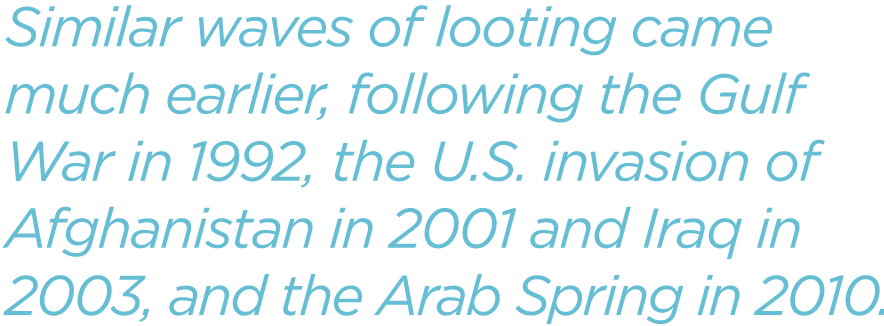Ancient Art, Illicit Revenue
After a months-long investigation, European authorities arrested members of an international crime gang in June 2020 for ransacking ancient sites in Bulgaria and trafficking stolen archaeological goods worth millions of euros.
The operation—dubbed MEDICUS—began when British police tipped off Bulgarian police in March 2018 about suspicious trafficking of cultural goods out of the country, including ceramics, glass funeral urns, lamps, arrowheads, spears, and ancient coins. Many of these items—4,600 in total—dated back to the Roman period, with some from the Bronze Age, Iron Age, and Middle Ages.
The goods were excavated out of Bulgaria and smuggled into the United Kingdom by private transportation operators, often taking a route through Germany.
“This case confirms that the most common way to dispose of archeological goods illegally excavated is by entering the legitimate art market,” according to Europol. “This modus operandi takes advantage of the fact that the existence of these goods is not officially known, therefore their illicit origin can be hidden by providing them with a false backstory (fake documents of provenance).”
When most people think of art crimes, they think of the sexy, headline-grabbing thefts from major museums. Heists like that of the Isabella Stewart Gardner Museum or of the Mona Lisa. But art crime also includes antiquities trafficking, which experts say may be funding organized crime, terrorism, and rogue states.
This trend caught widespread attention after the Islamic State destroyed monuments and looted museums and archeological sites in 2012 to finance its operations. The United Nations Security Council, in response, adopted Resolution 2347 in March 2017, which said ISIS, al Qaeda, and other associated entities were engaging in this activity to fund their recruitment efforts and operational capability to carry out terrorist attacks.
But similar waves of looting came much earlier, following the Gulf War in 1992, the U.S. invasion of Afghanistan in 2001 and Iraq in 2003, and the Arab Spring in 2010. Along with the UN Security Council resolution, the U.S. Department of State extended its Rewards for Justice counterterrorism rewards program to include $5 million in rewards for information that leads to the disruption of antiquities trafficking networks that benefit the Islamic State, according to analysis by the RAND Institute, Tracking and Disrupting the Illicit Antiquities Trade with Open-Source Data.
“Although empirical constraints prevent a complete accounting of the scale or relative significance of the involvement of organized criminal, insurgent, and terrorist groups in funding terrorist activity, comparative analysis of the historical record demonstrates that these groups can engage in the trafficking process in three distinct ways: (1) by exercising oversight or direction of the initial looting of archaeological objects; (2) by facilitating, aiding, or taxing the transportation and smuggling of artifacts within and between countries; and (3) by obtaining known antiquities (through theft or purchase),” RAND found. “In each case, the role of antiquities in the market generates funds or items that can be sold or exchanged for weapons, equipment, or other necessary goods on the black market.”

Artifacts, for instance, can be looted and exported illegally from one nation only to be sold legally in another because of how that artifact is classified in the process.
“These ambiguities compound the practical objective of distinguishing between licit and illicit items in that establishing authenticity, provenance, and ownership are tasks that require specialized knowledge beyond most police and customs officers’ standard training,” according to RAND. “The resulting variations in the identification, enforcement, and prosecution of crimes related to the antiquities trade introduce additional uncertainties that obscure the volume and character of both the legal and black-market trade. Finally, the art and antiquities community’s culture of secrecy conceals the identities of participants and undermines efforts to calculate the volume and value of goods traded.”
It’s also unknown how much money is at stake in this tradecraft because no government, international body, or research group has the ability to maintain comprehensive statistics on the global antiquities trade, RAND said.
What has been unusual, however, is the organized approach that the Islamic State took to looting and selling antiquities. In the lead-up to 2014, RAND found that the Islamic State distributed licenses to regulate antiquities trading and imposed taxes between 20 and 50 percent of proceeds from sales of these items in its territory. The Islamic State also had an administrative division that oversaw excavations of antiquities in its territory and paid—or pressured—curators and archeologists to help it locate valuable sites, direct excavation teams, and invest in metal detectors, heavy machinery, and more.
The focus on antiquities trafficking shows how the Islamic State sought to diversify its funding streams away from other mechanisms that might be subject to sanctions, such as oil, or would result in pushback from the local economy.
“Unlike human or drug smuggling, extortion, or kidnapping, which risk embittering local populations, the organized excavation of artifacts is unlikely to spur organized opposition in many contexts,” RAND found. “Indeed, it may provide an avenue to improve an organization’s relationship to impoverished populations.”
While this dynamic may exist for nonstate actors, regimes are involved in antiquities trafficking and looting, too, says Samuel Hardy, a postdoctoral fellow at the University of Oslo’s Norwegian Institute in Rome and former consultant for UNESCO.
The Assad regime in Syria, for instance, also had its army involved in looting and smuggling of antiquities, according to a report by the U.S. House of Representatives Financial Services Committee Task Force to Investigate Terrorism Financing.
Both the Islamic State and the Assad regime “are participating in looting and realizing income from the sales of antiquities,” according to testimony from task force member Patty Gerstenblith, research professor at the DePaul University College of Law and faculty director for the Center for Art, Museum, and Cultural Heritage Law. “Diachronic studies of satellite images of archaeological sites reveal historic patterns of looting pre-conflict.”
Hardy’s analysis supports this finding, and he says those involved in antiquities trafficking have said they were handling materials coming from all parties in the Syrian conflict—both the regime and the Islamic State.
“There were some cases where they had an incentive to lie—when they were paid for information,” Hardy adds. “But when you had them confessing to their own activity and incriminating to everyone their involvement, that does seem to be fairly convincing.”
And while much of the focus has been on how looted antiquities end up in Western markets (at least $100 million worth, annually), RAND’s research suggested that antiquities from the Middle East and Levant are also winding up in Iran, Turkey, the Persian Gulf States, and other nearby countries.

“Furthermore, the prices being paid to middlemen for low- and medium-quality goods are on par with what would be paid in the end market in Europe or North America,” RAND found. “These observations are contrary to the assumption that middlemen are paid just a fraction of the final price as they help in moving antiquities to Europe or the United States. The implication of this finding is that it is important to tailor policy responses to the situation if, indeed, the supply chains for certain goods are different from what has been assumed.”
Work can be done to secure archeological sites themselves to prevent thefts and trafficking on the market. Global partners have also come together to train archaeologists, curators, and other museum stakeholders about how to document their collections and findings. In Syria, for instance, most of the country’s 34 national museums transferred their artifacts to warehouses for safekeeping. But items that were later trafficked were looted from recent excavations and warehouses at archaeological sites.
“These items are not listed or cataloged yet, and thus looters believe they are easier to sell,” said Cristina Menegazzi, an official from UNESCO who spoke with the RAND report authors.
Having this documentation helps establish the legitimate ownership of the item if its stolen. Documentation of an item’s origin—and initial ownership—can help law enforcement intervene when suspicious items pop up on the market, according to RAND.
Training cultural properties stakeholders on documentation of their collections is one aspect of what the FBI does through its Art Crime Team, says Tim Carpenter, FBI Art Crime Team lead.
“We don’t stand on an island. We can only do our job with collaborative effort from law enforcement and from the private sector—academia, museums, and collectors,” Carpenter says. “We have a big training piece, and in normal years we do a lot of it—whether that’s in person through workshops and international training in Bogota, Peru, Saudi Arabia.”
Once these items are stolen, they sometimes move on to dealers and auction houses that can help legitimize them, says Andy Davis, CPP, founder of Trident Security and chair of the ASIS International Cultural Properties Community.
“There are still many, many cases where auction houses are selling looted artifacts. They’re not doing their due diligence, and governments are tightening up in response,” he adds. “Sales have been stopped until provenance has been proven.”
For instance, in June 2020 Christie’s withdrew four Greek and Roman antiquities from a planned auction. Professor Christo Tsirogiannis, forensic archaeologist, associate professor, and research fellow at the Aarhus Institute of Advanced Studies, University of Aarhus, spoke with The Guardian and said he had evidence that the items—a Roman marble hare, a Roman bronze eagle, and two Attic vases—were looted from their country of origin.
In a statement on “cultural stewardship,” Christie’s said that looting of archaeological sites is a major concern in the art world.
“We want to play our part in sending a clear message to those who participate in the illicit trade in cultural property looted and trafficked from conflict zones cannot be sold in the open market,” Christie’s said. “When handling works of antiquity or any work of art, Christie’s adheres to bilateral treaties and international laws related to cultural property and patrimony. We have strict procedures in place to help ensure we only offer works of art which we are entitled to sell and, as a part of that due diligence, we work closely in partnership with many national and international organization that pursue the same goals.”
Along with measures to physically protect dig sites, museums, and warehouses, there are policy responses that could mitigate antiquities trafficking. The RAND report authors recommended a variety of approaches, including increasing fear of law enforcement by sharing stories of the risk of illicit trades; increasing skepticism about fakes and replicas; and undermine trust in the market by increasing the “perceived threat of surveillance” on platforms where antiquities are sold.
“For high-value goods and key nodes in the network, effort by police and customs officials can successfully identify and prosecute criminal actors,” according to the RAND report. “However, these enforcement actions are time consuming, costly, and often require significant cross-border cooperation by law-enforcement agencies, which can often be difficult to organize. Instead, a broader-based approach aimed at undermining the trust among illicit actors and in the technologies they rely on could disrupt the illicit market more broadly and cheaply.”
Megan Gates is senior editor at Security Management. Connect with her [email protected]. Follow her on Twitter: @mgngates.
